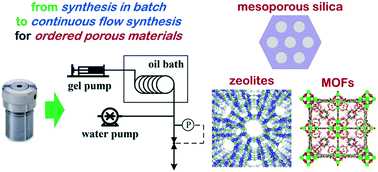Continuous flow synthesis of ordered porous materials: from zeolites to metal–organic frameworks and mesoporous silica
Abstract
Ordered porous materials are a class of materials featuring a well-defined framework that forms nanometer-sized channels and cages. Prominent examples of ordered porous materials include zeolites, mesoporous silica and metal–organic frameworks (MOFs), which have been extensively studied owing to their existing and potential applications in various fields. Driven by such application prospects, continuous flow synthesis is an attractive route for the preparation of these materials, as it can overcome the drawbacks (e.g., low efficiency and lack of flexibility) of the batch process that currently dominates the production. Establishment of the continuous flow synthesis of ordered porous materials, however, is not a simple switch of reactors. The challenge comes in part from the unique features of the crystallization of ordered porous materials, which typically involves a series of complicated assemblies in multiple phases. A successful continuous flow synthesis is therefore only achieved upon a comprehensive consideration from both chemistry and engineering perspectives. In this review, we present the challenges, concepts and successful examples of the continuous flow synthesis of ordered porous materials, with a focus on examining under what conditions the continuous flow synthesis could be feasible and exert positive effects on synthesis outcomes. We also offer our perspectives on principal challenges and future developments, which are expected to steer further studies on the continuous flow synthesis of ordered porous materials.



 Please wait while we load your content...
Please wait while we load your content...